PCSTATS regularly
hears about the latest technological advancements coming out of the big 5 motherboard manufacturers's factories in Taiwan, but most of the time we're not allowed to disclose any details to you. It's kind of like knowing a really great secret, but not being able to let it slip.... ahhh the stories I could tell you!
You may or may not be aware of something called a
capacitor. It's an electrical component that in the most basic sense stores and
releases electricity quickly. Capacitors are a common component on motherboards,
and a few years ago lots and lots of them began failing. They blew up, they burst, the little aluminum cans cracked, popped, and leaked gooey brown electrolyte all over the place. Motherboards from almost every maker suffered from this problem, leaving users stuck with out of warranty boards that no one wanted back, and no longer worked.
The problem of burst capacitors was an industry wide
epidemic, although ABIT suffered the worst of it by far. What caused poor quality electrolytic capacitors to burst after 3 years or so is a story of industrial espionage, stolen chemical recipe's, and cut rate electronic component prices. Motherboard makers learned a good lesson (we hope), and thankfully for consumers the use of higher quality Japanese-made electrolytic capacitors, and conductive polymer solid-state aluminum capacitors has grown dramatically. The latter are the type of capacitors mostly found on videocards, or in the CPU's power supply circuitry. Solid state capacitors improve overall stability, and last significantly longer than the electrolytic variety.
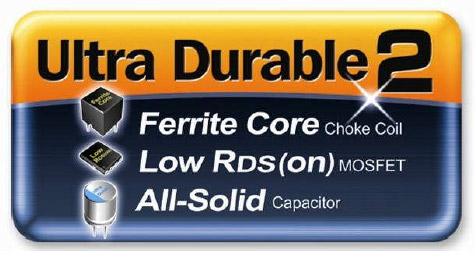 Companies like Gigabyte
have seized on this issue and now almost exclusively use these high end kinds of
capacitors on flagship motherboard models. For them it's good brand assurance,
for consumers it hopefully translates into more reliable gear.
Companies like Gigabyte
have seized on this issue and now almost exclusively use these high end kinds of
capacitors on flagship motherboard models. For them it's good brand assurance,
for consumers it hopefully translates into more reliable gear.
Recently, Gigabyte made some quiet announcements about its
application of solid state capacitors paired with improved ferrite core
choke coils and Low RDS MOSFET's. The combination of all three parts, according
to Gigabyte, helps reduce temperatures, improve power efficiency and hence
stability. The collection has been suitably marketed as Gigabyte Ultra Durable
2.
While a background in electronics is necessary to really
understand how the interaction of these three components results in a better
product, the basic gist of the technology is a topic we think worth
sharing with our readers. After all, once PCSTATS tests a motherboard there
really isn't any way for us to determine how well it will perform over the next
couple years. The average desktop motherboard lifecycle lasts from 6 months to 3
years, and we think it should operate reliably for at least that span of
time.
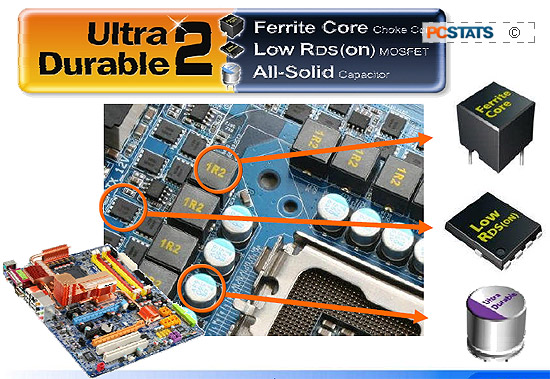
If you've never looked twice at motherboard and know nothing about what all
the little black and grey spots actually are, let alone do, you're in for a
treat. In the above slide are the three components of Gigabyte's Ultra Durable 2
approach. This is hardly a unique collection of electrical components, so it's
mainly significant because Gigabyte is making an effort to stress build quality
over features. Desktop motherboards aren't build to the same standards as a
server platform, so any nods towards increased reliability are welcome in
PCSTATS's books. Shown here are the Ferrite Core choke coil (this helps filter
out EMI/RF interference), the LOW RDS(on) MOSFET (power circuitry), and the
'All-Solid' Polymer capacitor.
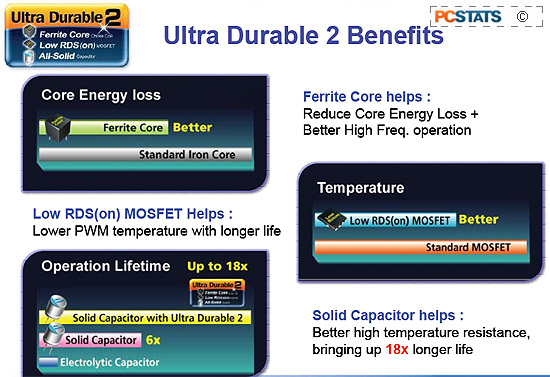
Compared to standard Electrolytic capacitors which use a fluid electrolyte,
the 'all-solid' style polymer capacitor is beneficial because it has a longer
lifespan for the same given elevated temperature that is common to the inside of
a computer. As temperatures increase, the lifespan of electrolytic capacitors
begins to decline. The same general rule of thumb holds true for MOSFETs as
well, and according to Gigabyte's information the LOW RD(on) variety can operate
with decreased heat output. Ferrite Core RF chokes seem pretty standard
equipment for motherboards, so we're not exactly sure why they are being
compared to the iron core variety.
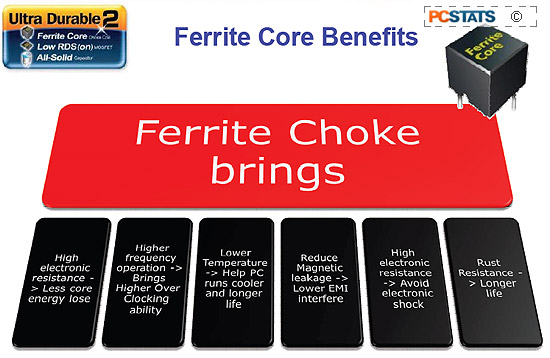
A Ferrite Core RF Choke has high electronic resistance, better high frequency
operation, operates at a lower temperature, has reduced magnetic leakage, and
several other qualities Gigabyte engineers feel are desirable. To be frank,
lowered rust resistance reads like a non-issue-feature.
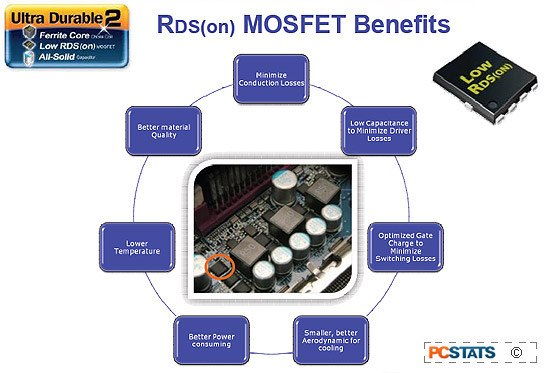
Power circuitry around the processor socket is partially composed of
MOSFETs. The RDS (on) style is a low profile board mount component which
has several positive qualities compared to the traditional variety, says
Gigabyte. Among them are lower heat production, lower capacitance, optimized
gate charge, better power consumption, etc. If you haven't taken
electronics in University your eyes are probably glossing over as you learn
about these tiny devices you've never heard about, so bare with us.
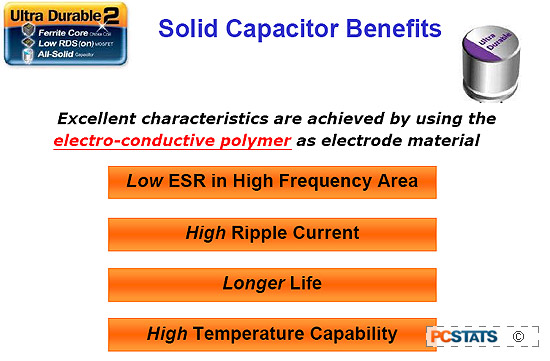
The most visible component that you should look for are solid-state Low ESR
conductive polymer capacitors. These are housed in very distinguishable
aluminum cans, and will not burst or leak. Good capacitors will not make your
computer faster, but they will ensure it runs reliably longer. The
electro-conductive polymer capacitor does not use electrolyte, so they will not
dry out, leak, or suffer gas buildup and burst. The circuit level benefits of
this type of capacitor are noted above in the slide. How solid-state polymer
capacitors compare against electrolytic capacitors is broken down
below.
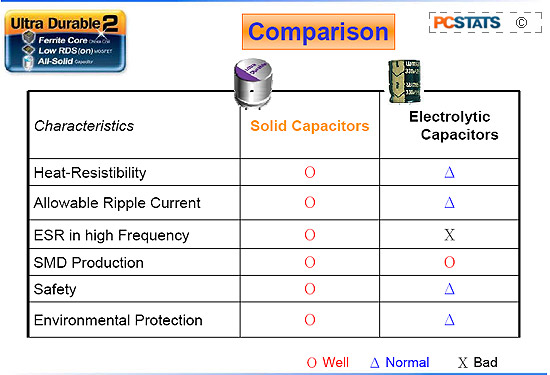
While the laymen may be challenged by such board-level component choices, the
underlying issues here are improved electrical reliability, decreased operating
temperature, and increased motherboard performance in its lifespan. Whatever the
effect of Gigabyte's Ultra Durable 2 component choices, I think we can all agree
it's good the industry is addressing product reliability more directly.
Behind the Scenes with the TechBrief
In this first of many TechBriefs, PCSTATS goal is just to share some of the
behind the scenes information we receive each week. Technology advances very
quickly, and while benchmarks and feature lists are very important tools for
researching the computer gear you're interested in, sometimes it's good to know
about what goes into a motherboard that makes it stand out from seemingly
identical products from a dozen other companies. This PCSTATS TechBrief
gives you a look at info you are unlikely to be exposed to in the computer
store. It is important to note that the TechBrief is not presenting our opinions,
and we're not dishing out the final word on one technological option or
another.

